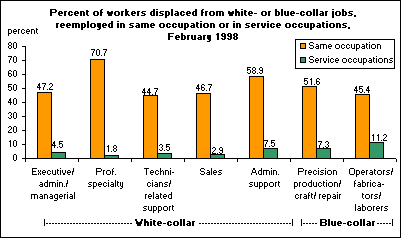An official website of the United States government
 United States Department of Labor
United States Department of Labor
Of the workers who were displaced in 1995-96 and reemployed in February 1998, those displaced from professional jobs were most likely to return to the same broad occupational group.

[Chart data—TXT]
Seventy-one percent of workers displaced from professional specialty jobs were reemployed in the same broad occupation in early 1998. Technicians and workers in related support occupations, and operators, fabricators, and laborers had the smallest proportion returning to the same broad category of job—45 percent.
Of the 1.7 million workers displaced from white- and blue-collar jobs reemployed in February 1998, 6 percent moved into the service occupations, jobs that usually pay the lowest and offer the fewest employee benefits. Workers displaced from operator, fabricator, and laborer occupations had the highest proportion (11 percent) who had taken service jobs while professional specialty jobs had the lowest—2 percent.
Displaced workers lose their jobs because their plants or companies close down or move, their positions or shifts are abolished, or their employers do not have enough work for them to do. Statistics here are for "long-tenured workers"—those who had been in their jobs for 3 years or longer.
These data are from a February 1998 supplement to the Current Population Survey. Note that the percentages in the chart are for displaced workers employed at the time of the survey. Find more information on displacement in "Worker displacement in the mid-1990s," by Steven Hipple, Monthly Labor Review, July 1999.
Bureau of Labor Statistics, U.S. Department of Labor, The Economics Daily, Displaced professional workers most likely to return to same occupation at https://www.bls.gov/opub/ted/1999/oct/wk2/art04.htm (visited November 10, 2024).

